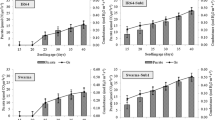Abstract
Flash flood causes a serious damage to rice crops in northern and eastern parts of Bangladesh almost every year. This study was designed to identify useful agronomic parameters for evaluation of submergence tolerance and to evaluate genotypes by multiple agronomic parameters for submergence tolerance at different growth stages. Twenty-one aman rice genotypes were tested against three submergence treatments viz. (i) no submergence or control, (ii) submerge at 10 days after transplanting (DAT), and (iii) submerge at 30 DAT. The experiment was laid out in a split plot design with three replications. The plants were completely submerged in the tanks for 14 days. Dry matter production, growth, yield, and yield components of rice were significantly reduced due to interaction effect of genotypes × submergence. Submergence at the early stage of growth (10 DAT) was more detrimental to plant growth than what happened at later stages (30 DAT). Wide genotypic differences in relative submergence tolerance based on grain and tiller numbers were identified. Grains and tiller numbers contributed most of the variation to seed yield among parameters investigated. When genotypes were ranked for submergence tolerance based on the means of multiple parameters, dramatic changes of submergence tolerance at early and later stages were observed in four genotypes; BRRI dhan33, Lalchikon, Achin and Sadamota were identified with a favorable combination of submergence tolerance. Cluster group ranking of genotypes based on multiple agronomic characters can be applied in submergence tolerance breeding to evaluate submergence tolerance and may have great advantage over conventional methods.
Similar content being viewed by others
References
Barding JGA, Fukao T, Béni, S, Bailey-Serres J, Larive CK. 2011. Differential metabolic regulation governed by the rice SUB1A gene during submergence stress and identification of alanylglycine by 1H NMR spectroscopy. J. Proteome Res. 11(1): 320–330
Bangladesh Bureau of Statistics (BBS). 2015. Yearbook of Agricultural statistics of Bangladesh. Bangladesh Bureau of Statistics. Stat. Div., Ministry of Planning. Gov. Peoples Repub. Bangladesh, Dhaka. 254
BRRI (Bangladesh Rice Research Institute). 2015. “Adhunik Dhaner Chash,” 22nd edition. pp 10–11
BRRI (Bangladesh Rice Research Institute). 2017. “Adhunik Dhaner Chash,” 16th edition. Pp 08–12
Chaturvedi GS, Misra CH, Singh ON, Pandey CB, Yadav VP, Singh AK, Singh RK. 1995. Physiological basis and screening for tolerance for flash flooding. PP. 79–96. In: KT Ingram, ed., Rainfed Lowland Rice Agricultural Research for High Risk Environment. International Rice Research Institute, Los Banos, Philippines
Colmer TD, Pedersen O. 2008. Underwater photosynthesis and respiration in leaves of submerged wetland plants: gas films improve CO2 and O2 exchange. New Phytolo. 177(4): 918–926
Damanik RI, Maziah M, Ismail MR, Ahmad S, Zain AM. 2010. Responses of the antioxidative enzymes in Malaysian rice (Oryza sativa L.) cultivars under submergence condition. Acta Physiolog. Planta 32(4): 739–747
Duan M, Sun SS. 2005. Profiling the expression of genes controlling rice grain quality. Plant Mol. Bio. 59(1): 165–178
Fridman E, Zamir D. 2003. Functional divergence of a syntenic invertase gene family in tomato, potato, and Arabidopsis. Plant Physiol. 131(2): 603–609
Fukao T, Xu K, Ronald PC, Bailey-Serres J. 2006. A variable cluster of ethylene response factor-like genes regulates metabolic and developmental acclimation responses to submergence in rice. Plant Cell 18(8): 2021–2034
Ismail AM, Ella ES, Vergara GV, Mackill DJ. 2009. Mechanisms associated with tolerance to flooding during germination and early seedling growth in rice (Oryza sativa L.). Ann. Bot. 103(2): 197–209
Jackson MB, Waters I, Setter T. Greenway H. 1987. Injury to rice plants caused by complete submergence; a contribution by ethylerie (ethene). J. Expt. Bot. 38(11): 1826–1838
Jolliffe IT, Allen OB, Christie BR. 1989. Comparison of variety means using cluster analysis and dendrograms. Exp Agric. 25: 259–269
Kato Y, Collard BC, Septiningsih EH, Ismail AM. 2014. Physiological analyses of traits associated with tolerance of long-term partial submergence in rice. AoB plants. 6: 0–58
Khrais T, Leclerc Y, Donnelly DJ. 1998. Relative salinity tolerance of potato cultivars assessed by in vitro screening. Amer. J. Potato Res. 75: 207–210
Perata P, Voesenek LA. 2007. Submergence tolerance in rice requires Sub1A, an ethylene-response-factor-like gene. Trends Plant Sci. 12(2): 43–46
Quick WP, Schaffer AA. 1996. Sucrose metabolism in source and sink. In: E Zamarki, AA Schaffer. Photoassimilate Distribution in Plants and Crops: Sucrose-Sink Relationship. New York: Marcel Dekker: 115–158
Reddy MD, Mittra BN. 1985. Effect of complete plant submergence at different growth stages on grain yield, yield components and nutrient content of rice. Plant Soil 86(3): 379–386
Sarkar RK, Das S. 2003. Yield of rainfed lowland rice with medium water depth under anaerobic direct seeding and transplanting. Trop. Sci. 43(4): 192–198
Sugai K, Saito M, Nishiyama I. 1999. Effects of stepwise raising of the water level on increasing tiller number in rice plants (Oryza sativa L.). Jap. J. Crop Sci. 68(3): 390–395
Voesenek LA, Bailey-Serres J. 2015. Flood adaptive traits and processes: an overview. New Phytol. 206(1): 57–73
Weber H, Rolletschek H, Heim U, Golombek S, Gubatz S, Wobus U. 2000. Antisense-inhibition of ADP-glucose pyrophosphorylase in developing seeds of Vicia narbonensis moderately decreases starch but increases protein content and affects seed maturation. Plant J. 24(1): 33–43
Xu K, Xu X, Fukao T, Canlas P, Maghirang-Rodriguez R, Heuer S, Mackill DJ. 2006. Sub1A is an ethylene-response-factor-like gene that confers submergence tolerance to rice. Nature 442(7103): 705–708
Yin D, Chen S, Chen F, Guan Z, Fang W. 2010. Morpho-anatomical and physiological responses of two Dendranthema species to waterlogging. Environ. Exp. Bot. 68(2): 122–130
Author information
Authors and Affiliations
Corresponding author
Rights and permissions
About this article
Cite this article
Abedin, M.H., Al Mamun, M.A., Mia, M.A.B. et al. Evaluation of Submergence Tolerance in Landrace Rice Cultivars by Various Growth and Yield Parameters. J. Crop Sci. Biotechnol. 22, 335–344 (2019). https://doi.org/10.1007/s12892-019-0085-0
Received:
Revised:
Accepted:
Published:
Issue Date:
DOI: https://doi.org/10.1007/s12892-019-0085-0




